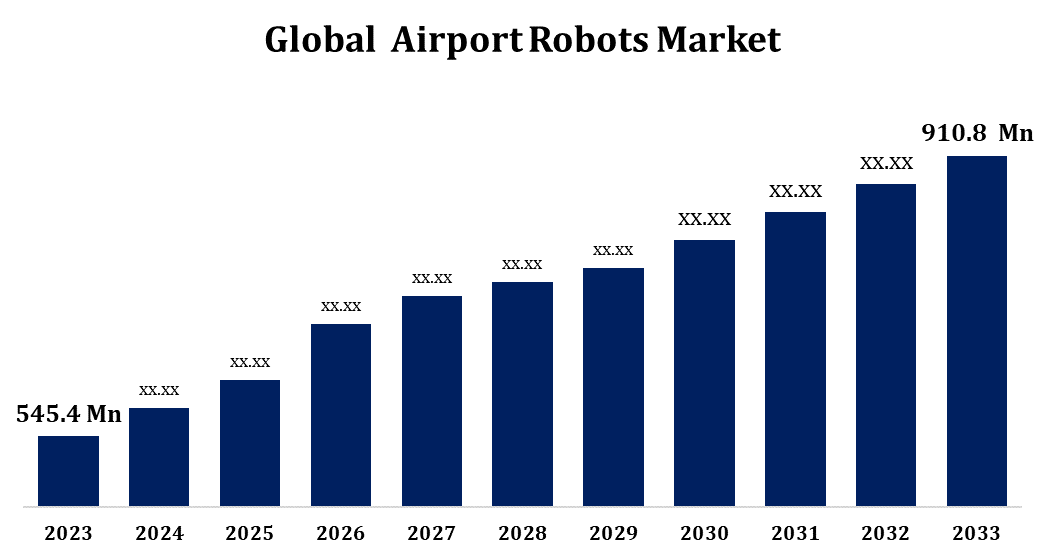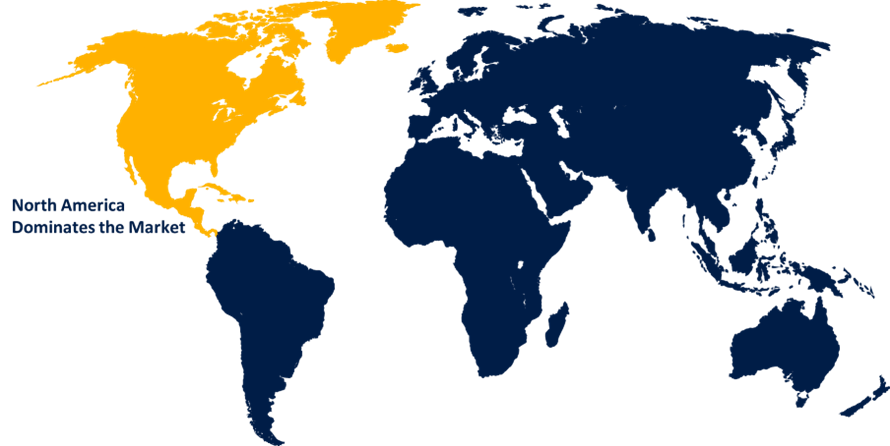Global Airport Robots Market Size, Share, and COVID-19 Impact Analysis, By Type (Humanoid and Non-Humanoid), By Application (Landside/Valet Parking and Terminal), and By Region (North America, Europe, Asia-Pacific, Latin America, Middle East, and Africa), Analysis and Forecast 2023 - 2033
Industry: Aerospace & DefenseGlobal Airport Robots Market Insights Forecasts to 2033
- The Airport Robots Market Size was valued at USD 545.4 Million in 2023.
- The Market Size is Growing at a CAGR of 5.26% from 2023 to 2033
- The Worldwide Airport Robots Market size is Expected to reach USD 910.8 Million by 2033
- Asia Pacific is Expected to Grow the fastest during the forecast period

Get more details on this report -
The Global Airport Robots Market Size is Expected to reach USD 910.8 Million by 2033, at a CAGR of 5.26% during the forecast period 2023 to 2033.
The airport robots market is experiencing significant growth driven by the increasing demand for automation and efficiency in airports worldwide. These robots perform various functions, including passenger assistance, baggage handling, cleaning, and security surveillance, enhancing the overall passenger experience and operational efficiency. Innovations in artificial intelligence (AI), machine learning, and robotics are enabling the development of advanced robots with enhanced capabilities, such as autonomous navigation and real-time communication. Airports in Asia-Pacific, Europe, and North America are early adopters, focusing on improving services and reducing operational costs. As global air traffic recovers post-pandemic, the demand for airport robots is expected to rise, with market players expanding their portfolios to include multipurpose robots capable of performing diverse tasks in dynamic airport environments.
Airport Robots Market Value Chain Analysis
The airport robots market value chain comprises several interconnected stages, from R&D to end-user implementation. Research and development (R&D) focuses on creating innovative robotics technologies, integrating AI, machine learning, sensors, and IoT to enhance functionality. Component suppliers provide critical parts like processors, sensors, motors, and software solutions. Robotics manufacturers assemble these components into specialized robots for various airport tasks, including customer service, security, cleaning, and baggage handling. System integrators customize robots to meet specific airport requirements, ensuring compatibility with existing systems and infrastructure. Distributors and sales channels then market and sell these robots to airports worldwide. The final stage involves the deployment of robots by airports to improve operations and customer experience, supported by ongoing maintenance, software updates, and after-sales service to maintain efficiency and reliability.
Airport Robots Market Opportunity Analysis
The airport robots market presents significant opportunities driven by increasing demand for automation, efficiency, and enhanced passenger experience in airports. The post-pandemic recovery in global air travel has accelerated the adoption of robotic solutions for tasks like contactless passenger assistance, security, and baggage handling. Emerging markets, especially in Asia-Pacific and the Middle East, are rapidly investing in smart airport infrastructure, creating strong growth potential for robotics providers. Innovations in artificial intelligence (AI), machine learning, and IoT are enabling the development of more advanced, multipurpose robots, expanding their capabilities. Additionally, the growing focus on sustainability offers opportunities for energy-efficient robotic solutions. As airports prioritize cost reduction and operational efficiency, the market is poised for substantial growth, with demand for customized and integrated robotic solutions rising sharply.
Global Airport Robots Market Report Coverage
| Report Coverage | Details |
|---|---|
| Base Year: | 2023 |
| Market Size in 2023: | USD 545.4 Million |
| Forecast Period: | 2023-2033 |
| Forecast Period CAGR 2023-2033 : | 5.26% |
| 2033 Value Projection: | USD 910.8 Million |
| Historical Data for: | 2019-2022 |
| No. of Pages: | 188 |
| Tables, Charts & Figures: | 110 |
| Segments covered: | By Type, By Application, By Region |
| Companies covered:: | ABB Ltd., Advanced Navigation and Positioning Corporation (ANPC), Avidbots Corp., Cyberdyne Inc., LG Corporation, SITA, SoftBank Group Corp., and Others |
| Pitfalls & Challenges: | Covid-19 Empact, Challenges, Growth, Analysis. |
Get more details on this report -
Market Dynamics
Airport Robots Market Dynamics
Growing Emphasis on Automating Airport Security and Cleaning Services to Support Growth
The growing emphasis on automating airport security and cleaning services is a key driver of growth in the airport robots market. As airports face rising passenger volumes and increased pressure to enhance safety, robots offer a reliable solution for efficient and contactless security screening, surveillance, and threat detection. Robots equipped with AI and advanced sensors can perform repetitive tasks such as temperature checks, crowd monitoring, and baggage screening with high precision, reducing human error. Additionally, autonomous cleaning robots equipped with UV sterilization capabilities are increasingly used to maintain hygiene standards, particularly in the post-pandemic era. This automation not only enhances operational efficiency but also minimizes costs and improves the passenger experience. As a result, airports worldwide are investing in robotic technologies to streamline security and cleaning processes, boosting market growth.
Restraints & Challenges
High initial costs and the complexity of integrating robots with existing airport infrastructure remain significant barriers, especially for smaller airports with limited budgets. Additionally, concerns over data privacy and cybersecurity are prevalent, as many robots rely on AI, sensors, and IoT, which involve collecting and processing sensitive passenger and operational data. Limited awareness and skepticism about the reliability of robotic solutions can also slow adoption. Furthermore, the need for frequent maintenance, software updates, and technical support can add to operational costs. Rapid technological advancements may render some robotic solutions obsolete, requiring continuous investment. Navigating regulatory environments, especially those concerning safety standards and data protection, poses another challenge for stakeholders in this market.
Regional Forecasts
North America Market Statistics

Get more details on this report -
North America is anticipated to dominate the Airport Robots Market from 2023 to 2033. The U.S. and Canada are leading adopters of advanced robotic technologies, integrating robots for various tasks such as passenger assistance, security screening, and cleaning. Airports are increasingly turning to robotics to handle growing passenger volumes, reduce operational costs, and maintain high safety standards. The region's strong technological ecosystem, with numerous companies specializing in AI, robotics, and automation, supports innovation and the deployment of cutting-edge solutions. Government initiatives to upgrade airport infrastructure and enhance security also contribute to market growth.
Asia Pacific Market Statistics
Asia Pacific is witnessing the fastest market growth between 2023 to 2033. Emerging countries are leading the adoption of airport robots, utilizing them for tasks such as passenger guidance, security, baggage handling, and cleaning to enhance efficiency and the overall traveler experience. The region's focus on technological innovation, combined with substantial investments in AI, robotics, and IoT, is driving market growth. Additionally, airports in Asia-Pacific are adopting robotics to manage operational challenges, such as labor shortages and the need for contactless services post-pandemic. Despite the growth potential, challenges like high costs, technical complexities, and regulatory hurdles could impact the market’s expansion in the region.
Segmentation Analysis
Insights by Type
The non-humanoid segment accounted for the largest market share over the forecast period 2023 to 2033. These robots, designed for specific tasks like baggage handling, cleaning, security surveillance, and cargo transport, offer enhanced efficiency and operational reliability. Unlike humanoid robots, non-humanoid models are cost-effective, simpler to deploy, and can perform repetitive tasks with precision and speed, reducing human error. Autonomous cleaning robots equipped with UV sterilization and advanced sensors are gaining popularity for maintaining hygiene standards, especially in the post-pandemic era. Security robots provide constant surveillance and threat detection, enhancing airport safety. The market growth is supported by continuous technological advancements in AI, machine learning, and IoT, which improve the capabilities of non-humanoid robots, making them indispensable in modern airport operations.
Insights by Application
The terminal segment accounted for the largest market share over the forecast period 2023 to 2033. Terminal robots are deployed for various functions, including passenger assistance, wayfinding, check-in, luggage transport, retail services, and cleaning. These robots help streamline processes, reduce wait times, and offer contactless services, which have become crucial in the post-pandemic environment. Advanced AI and machine learning capabilities enable robots to provide real-time information, personalized guidance, and multilingual support, improving passenger satisfaction. Furthermore, robots equipped with sensors and autonomous navigation help manage crowd control and maintain hygiene standards. As global passenger traffic rebounds and airports seek to modernize, the demand for terminal robots is expected to rise, driving growth in this segment.
Recent Market Developments
- In April 2024, to improve safety, the Alaskan government stationed Aurora, a robotic dog, at Fairbanks Airport. The robot was funded by a federal grant, was created by Andrea Deppner, and discourages wildlife with the use of cutting-edge technology.
Competitive Landscape
Major players in the market
- ABB Ltd.
- Advanced Navigation and Positioning Corporation (ANPC)
- Avidbots Corp.
- Cyberdyne Inc.
- LG Corporation
- SITA
- SoftBank Group Corp.
- Others
Market Segmentation
This study forecasts revenue at global, regional, and country levels from 2023 to 2033.
Airport Robots Market, Type Analysis
- Humanoid
- Non-Humanoid
Airport Robots Market, Application Analysis
- Landside/Valet Parking
- Terminal
Airport Robots Market, Regional Analysis
- North America
- US
- Canada
- Mexico
- Europe
- Germany
- Uk
- France
- Italy
- Spain
- Russia
- Rest of Europe
- Asia Pacific
- China
- Japan
- India
- South Korea
- Australia
- Rest of Asia Pacific
- South America
- Brazil
- Argentina
- Rest of South America
- Middle East & Africa
- UAE
- Saudi Arabia
- Qatar
- South Africa
- Rest of the Middle East & Africa
Frequently Asked Questions (FAQ)
-
1 What is the market size of the Airport Robots Market?The global Airport Robots Market is expected to grow from USD 545.4 million in 2023 to USD 910.8 million by 2033, at a CAGR of 5.26% during the forecast period 2023-2033.
-
2. Who are the key market players of the Airport Robots Market?Some of the key market players of the market are ABB Ltd., Advanced Navigation and Positioning Corporation (ANPC), Avidbots Corp., Cyberdyne Inc., LG Corporation, SITA, and SoftBank Group Corp.
-
3. Which segment holds the largest market share?The terminal segment holds the largest market share and is going to continue its dominance.
-
4. Which region dominates the Airport Robots Market?North America dominates the Airport Robots Market and has the highest market share.
Need help to buy this report?